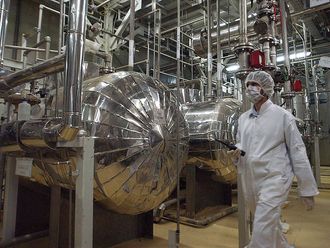New York: A Daesh convoy stuck in the middle of the Syrian Desert for more than two weeks because of US air strikes finally reached eastern Syria late Wednesday night, according to reports from citizen journalist groups in the area. The convoy reached the territory held by Daesh, despite vows by the US-led coalition fighting the group that it would not be allowed to do so.
There was no official confirmation of the reports, which were from credible contacts in eastern Syria that were monitored in Damascus, the capital. A spokesman for the coalition, Col. Ryan Dillon, said early Thursday in Baghdad that he had no comment on the matter.
The reports said that the remnants of the convoy, which originally carried 600 Daesh fighters and their family members, had reached Mayadin in eastern Deir Al Zor province, near the border with Iraq.
The coalition announced last Friday that it was removing surveillance aircraft from the vicinity of the convoy at the request of the Russian authorities, because Russian warplanes were involved in supporting a Syrian army advance into Deir Al Zor province. That advance took the Syrian forces directly past the area where the convoy was stranded, near the town of Sukhna.
The convoy, originally consisting of 17 vehicles — buses and ambulances — and escorts from the Lebanese Hezbollah militia group, had been stuck near Sukhna, on the main highway from Damascus to the city of Deir Al Zor, where the Syrian army claimed it ended a blockade by the Daesh last week. The convoy was whittled down to 11 vehicles when six returned to Syrian government territory in western Syria, coalition officials said.
In a deal brokered by Hezbollah, the Daesh militants and their families had been allowed to leave an area on the Lebanese-Syrian border in exchange for turning over the bodies of Lebanese soldiers and Hezbollah militants, as well as an Iranian officer of the Islamic Revolutionary Guards Corps. They were promised free passage to the town of Al Bukamal, in the southern part of Deir Al Zor province.
But the US-led coalition bombed the highway to prevent the convoy from advancing and carried out air strikes against Daesh units said to be coming to the convoy’s aid, but did not strike the convoy itself because of the presence of women and children.
Coalition officials said the US military and its allies were not a party to the deal among Hezbollah, Lebanon, Syria and the Daesh, and did not want to let Daesh fighters to return to the battlefield. Iraq also criticised the deal because the convoy’s intended destination, Al Bukamal, is near Iraqi battlefronts against Daesh.
According to the antigovernment sources monitored in Damascus, once the US surveillance aircraft withdrew from the area on Sept. 8, the convoy was free to move, but Hezbollah extracted further concessions from Daesh, including the release of a Hezbollah prisoner of war, Ahmed Martouk, who was turned over alive. In exchange, Hezbollah turned over two Daesh leaders to the group.
The convoy was allowed to cross through government-held territory to Mayadin, near the Iraqi border, about halfway between Deir Al Zor and Al Bukamal. The antigovernment sources estimated that the convoy had been reduced to about 200 fighters, plus family members; others had sneaked away.
The convoy’s predicament was another indication of the declining fortunes of Daesh in the region.
It lost its last major city in Iraq, Tal Afar, the week before, and coalition-backed forces have taken much of the city of Raqqa, the Daesh ‘capital’, as well. But the latest development illustrates the complexities of the Syrian battlefield, where both US-led coalition aircraft and Russian planes are backing rival factions, some of which are fighting one another as well.











